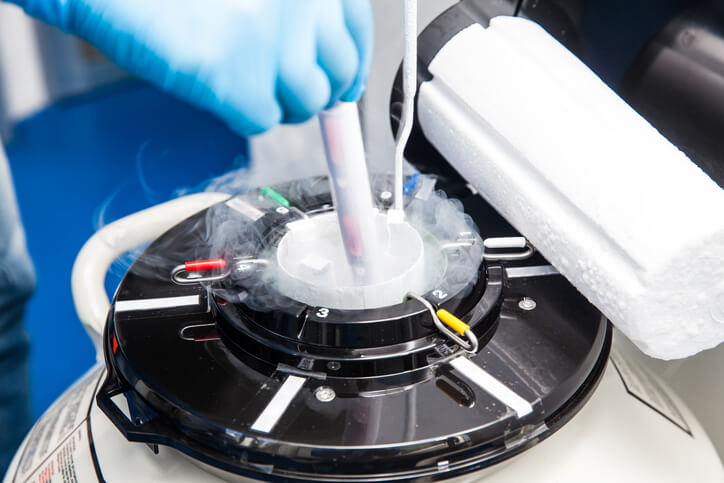Many parents-to-be love creating a memory book documenting their child’s journey into the world — and just because your child is being carried by a surrogate doesn’t mean that you can’t also create a memento for this important time in your life.
But, how exactly do you create a surrogacy memory book? Won’t it be complicated when a surrogate is involved?
Absolutely not! When you have a positive, genuine relationship with your surrogate, making a surrogacy memory book will be easier than you think. While it’s true that your child’s memory book will be slightly different because of the way they were brought into the world, a surrogacy memory book doesn’t need to be incredibly different from a memory book for those born traditionally and those brought into a family through adoption.
Hear more about surrogacy as an intended parent from intended parents who have become parents through surrogacy on our Instagram.
Here, find a few tips to help you if you are considering creating a surrogacy memory book:
1. Design it chronologically.
If you’ve never made a surrogacy memory book, it can be intimidating to start. However, when you decide to frame your book chronologically, this will give you an easy beginning, middle and end to work around.
When starting your surrogacy memory book, remember that this should be a happy document, so it may not be best to dwell upon the infertility struggles and other challenges that made you choose surrogacy. Instead, simply mention that you decided on surrogacy at a certain point in time, and then move forward with the rest of your book from there. You can use the important dates in your surrogacy journey as a starting point, and then include any other fun moments or mementos as fillers.
2. Include a table of contents.
Children often grow to love the memory books of how they came to be, and they may enjoy reading it over and over. They will usually fixate on different aspects of your surrogacy journey at different times in their life, so you may consider a table of contents to aide that. This way, your child (and anyone viewing the surrogacy memory book) can quickly flip to the section that they want to read about most.
3. Include the surrogate.
This may seem like a no-brainer, but there are many ways you can choose to include your surrogate in your child’s surrogacy memory book. In addition to including a page about who she is and how she was involved throughout the journey, you may also wish to let a surrogate add to the memory book, as well. You might suggest that she write a letter to your child about her experience, any fun moments she had, and why she chose to be a surrogate. Your surrogate can be instrumental in providing photos and other mementos that you can use in the memory book. For this reason, it can be a good idea to inform the surrogate of your plans to make a memory book as early as possible. Many surrogates are excited at this opportunity to document their experience!
4. Include other important people in your surrogacy journey.
Your surrogate isn’t the only one who was involved in bringing your child into the world, so consider including people like your surrogacy specialist, fertility professional and the doctor who delivered your baby. You can include photos and names and, depending on your relationship with these professionals, ask them if they also want to contribute to the memory book.
5. Make sure to explain certain aspects of the surrogacy experience.
Remember that the people who will eventually read your child’s surrogacy memory book may not understand how surrogacy works. Therefore, when you include important parts of the surrogacy process (like finding a surrogate or the embryo transfer), you should consider explaining them, as well. Not only will this help your child understand their surrogacy journey from an early age, it will also help spread awareness about the beauty — and truth — of surrogacy.
6. Leave room for future pages.
Surrogacy is not just a one-time process; your child’s surrogacy story will impact the rest of his or her life. Therefore, leave blank pages or pages with certain prompts for different times in your child’s life. For example, if you anticipate your child meeting your surrogate one day, create a page for that, leaving open spots for photos and other mementos.
7. Protect your surrogacy memory book.
Often, a surrogacy memory book can become a treasured item for a child. But, knowing how messy (and forgetful) children can be, take the steps early on to protect this book from future damage. Consider laminating any homemade scrapbook pages or placing them in protective sleeves, or work with a professional bookbinding and creation company like Shutterfly to include scanned documents, rather than precious, sentimental originals.
—
More than anything else, when you’re creating your child’s surrogacy memory book, don’t forget to make it your own! There is no “right” way to make a memory book; instead, just focus on including what is important in your surrogacy story and what you want your child to know growing up. The best surrogacy memory books aren’t always the most creative ones; they are the ones in which intended parents have taken the time and effort to create something special.
You can always contact our surrogacy specialists at American Surrogacy for more tips and suggestions when creating your surrogacy memory book. To learn more today, please call 1-800-875-2229(BABY).









